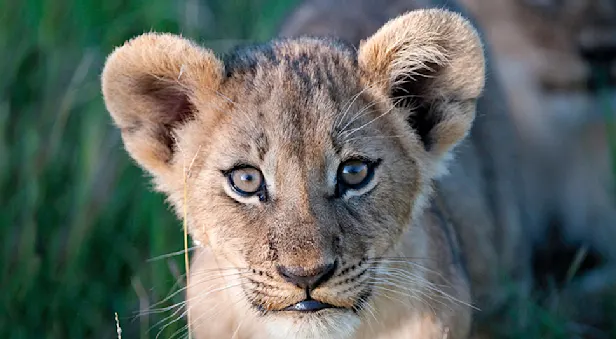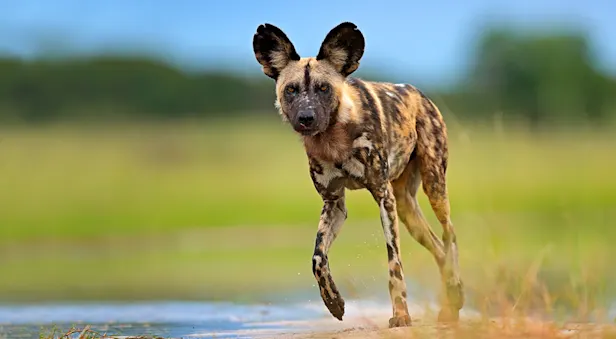Lion Facts | Southern Africa Wildlife Guide
Physical Characteristics
The largest of Africa's big cats, weighing two to four times more than their cousins, the leopard and cheetah.
Show greater differences between the sexes than other cats. Males have manes that are fully developed by 4 years old, and they are up to 50 percent heavier than females.
Newborns have a spotted coat, which, over the first two years, gradually becomes a nearly uniform tawny color.
Like many of their prey, lions have a slightly counter-shaded pelage, which is darker on top and grades to lighter underneath. This tends to neutralize the three-dimensional shadowing created by overhead lighting from the sun, as the shadow is lightened by the whitish belly fur. The overall effect is to enhance camouflage by flattening form.
Habitat
Lions often inhabit wooded and bushed areas, and despite being frequently viewed in open grasslands, they actually favor habitats that provide cover for sheltering young and hunting. They seem to be successful in keeping healthy populations at reserves and parks, although they struggle when their habitat is fragmented by human infrastructure and roads. Lions are most active during dawn, dusk and periodically throughout the night. During daylight hours they can be found lounging or sleeping in the shade.
Roaring Success
While both lions and lionesses roar, the male’s vocal call is deeper and more deafening. Roaring generally lasts 30 to 40 seconds, recognizable as a series of lengthy moaning grunts followed by a sequence of short ones. Most likely, the call is used to maintain and defend territories, or perhaps, since roaring most often occurs at night, dusk and dawn, it is used to locate one another in a lack of light. A roar can be heard from up to 2 miles away, and lions are able to perceive certain individuals’ roars. Cubs will attempt to mimic roaring lions, and their mothers encourage this with soft moaning roars.
Lion Society
Lions are the most social members of the cat family. Prides generally consist of two to 15 females, their young cubs and a group of males, many of whom are brothers unrelated to the lionesses. Young lionesses are initiated into the pride to breed alongside their mothers and aunts, while adolescent males leave and strive to find a new pride to overtake.
Lion prides are ever-changing, as males only hold sway over a group of females for an average of 18 months before they are ousted, sometimes even killed, by stronger or more numerous newcomers. Only large male coalitions can aspire to control a pride over a period of relative stability.
Breeding
Females may produce as many as six litters during their lifetime. Lionesses come into season sporadically; the period between heats varies from a couple of weeks to months. Estrous lasts about a week, during which time males compete for receptive females. Male coalition partners, however, are rarely aggressive towards each other in competition over potential mates. They seem to operate on an agreed first-come, first-served system.
It is quite normal for either partner to initiate mating. The male’s technique begins with the so-called “mating snarl,” which has been described as a sneeze-like grimace. These vocals may or may not convince the female to stop and crouch. The female, if she initiates, keeps unusually near the male and may rub her head on his shoulders and sides, emitting a deep, sensuous rumble, walking sinuously around him and flicking her tail. She may even back into him and crouch to stimulate his interest.
During copulation, the female yowls and the male often bites her neck in a manner similar to the subduing neck bite of domestic cats. After ejaculating, the male leaps off, often to avoid a blow from the female, who may spin around when his weight is removed. Both animals then lie down. During one consorting week, the pair may copulate over 300 times, an average of once every 15 minutes during the waking hours. A successful pride male may mate 20,000 times in his lifetime.
Gestation is relatively short—only three and a half months. In a secluded, well-hidden spot, often among rocks or dense riverside vegetation, the lioness, will give birth to two or three cubs on average. She suckles and remains with them for long periods, only occasionally returning to the pride to hunt and feed. After about a month, the cubs are led to the pride.
Lionesses appear to synchronize breeding activity; it is not unusual for several females in a pride to have litters at the same time. Unlike other mammals, lion mothers will commonly tolerate suckling by cubs of others in the pride, because they are generally all related. By providing milk to cubs belonging to her sisters, a female aids in rearing young that carry some of her own genes. Females do, however, more readily nurse their own offspring who tend to approach boldly, mewing, purring and pushing their mothers’ faces before proceeding to suckle noisily. Cousins are more prone to sneak in from behind.
Nomadic males regularly kill cubs, presumably to eliminate rivals’ genetic material from the population. Cubs are also at risk from other predators, such as spotted hyenas and leopards. Due to these threats, a lioness keeps her brood well-hidden and will relocate to a new, secure spot if the original location is disturbed.
Feeding Habits
Lions’ predatory habits have enhanced the evolution of a large head and powerful jaws equipped with long canines. They have sizeable feet, and retractable claws unsheathe to present a catching tool as wide as a squash racket. Lions are the largest species of African carnivore and routinely tackle prey, such as buffalo, that are beyond the abilities of other predators. They stalk and ambush like cheetahs and leopards; but similar to hyenas and hunting dogs, they also hunt collectively.
The majority of a lion’s prey is medium to large-sized ungulates, such as wildebeest and zebra. There is, however, considerable seasonal and locational variation. At all times, lions are opportunistic creatures and will eat small prey such as rodents, fledgling birds and ostrich eggs if given the chance. Males need to eat approximately 20 pounds of meat a day; 11 pounds are necessary to sustain females.
Females in the pride do most of the hunting, but males, with their superior strength and weight, gain first access to a kill once the dirty work is done. There is a reason, beyond sheer laziness, for these roles; males have a distinct disadvantage in stalking with their manes, which appear like haystacks moving through the grass. Hunting tactics depend on prey and habitat. In open habitats, lions tend to hunt at night, though they can be active during the day if there is enough vegetation to hide their approaches. River crossings and watering places are favorite sites for ambushes.
Stalking and rushing prey demands that lions get as close as possible. When several lions hunt together, they tend to try to encircle prey to cut off lines of escape. Experts disagree on whether or not lions pay attention to wind direction, though upwind hunts are usually more successful. Although a lion can eventually reach speeds of nearly 37 miles per hour, most of its prey can sprint faster. This means the lion must get within 100 feet before charging, overtaking, slapping down and finally grabbing the victim. Once captured, the prey is subdued and suffocated with a relatively quick neck bite or a sustained bite over the muzzle. Several lions may overcome larger prey together, and members of the pride may begin to open the victim while one lion is still suffocating it.
See Lions on These African Safaris

Botswana: Kalahari, the Delta & Beyond
Witness the spectacle of Botswana during the green season under changing skies, as the desert bursts forth with life, wildlife thrives with seasonal water, and new births fill the plains.

























